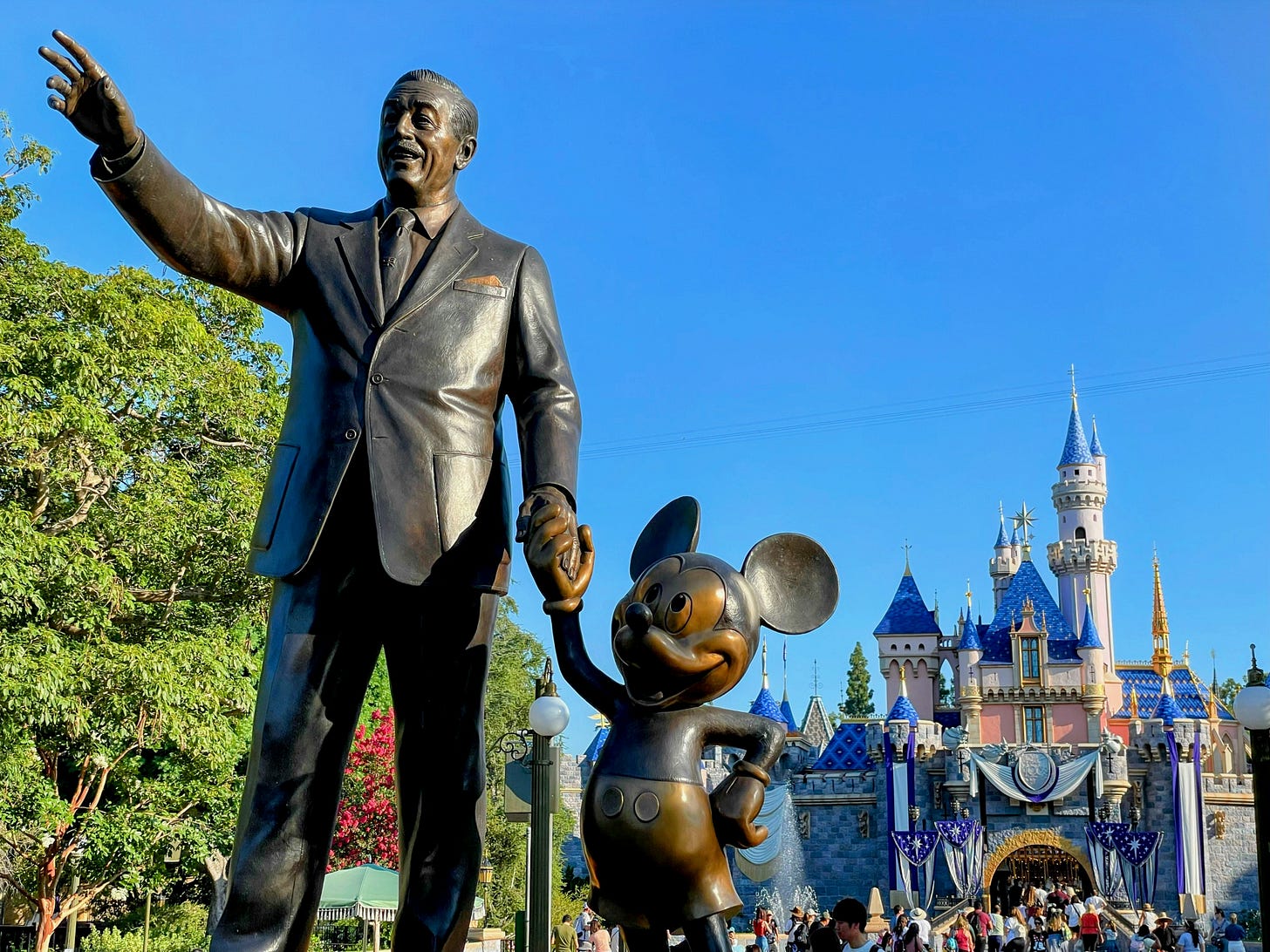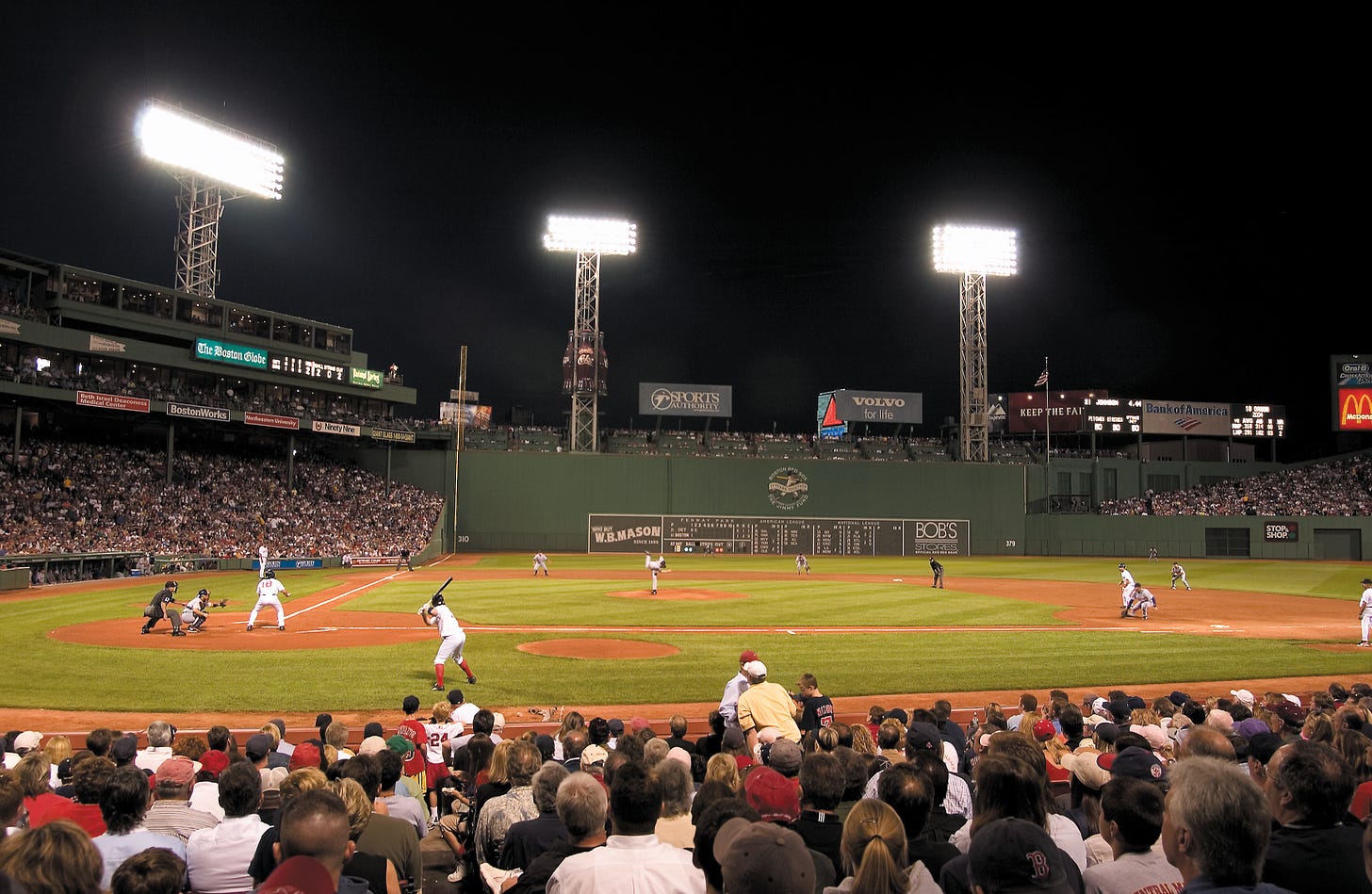Americana’s Price of Admission
Needs vs. wants, the middle class, and what the affordability debate is missing
I’m in the dying breed of people who still watch over 100 baseball games a year.1 In college, I’d submit myself as a lab rat for psych studies to muster up enough cash for a $9 student standing room ticket, a CharlieCard, and a Bud Light.2 The empty seats behind Pesky Pole beckoned squatters like me, and I knew come the 8th inning I could mosey my way over to prime seats by the dugout when tourists left after belting “Sweet Caroline.” Those days, I thought I was scrounging, weaseling around Fenway thanks to my student subsidies. Little did I know I had it good.
Since 2004, when the Red Sox won their first World Series in 86 years, the cost of being a hardcore fan has ballooned. Back then, getting tickets, watching games on TV, and buying merchandise cost $1,321, according to journalist
. Today, it’s $4,785, a 262 percent increase that more than triples wage growth over the same time.Let’s just focus on streaming. Growing up, I knew I could catch the Sox on my cable’s channel 51, the Celtics on channel 52, and the Patriots on channels 4 or 13. Simple enough. Today, to ensure I can watch most games for my teams, I need subscriptions to at least MLB.TV, Apple TV, YouTube TV, NBA League Pass, NFL Sunday Ticket, HBO Max, Amazon Prime, and Paramount. Together, Joon Lee places the cost of this bundle at $2,634 a year.34 (That’s why fans turn to illicit streaming sites like Streameast, which brought in 1.6 billion visitors over the last year before authorities brought it down this week.)
Now, I may just be another always-aggrieved Boston sports fan. But what’s happening to America’s pastime is happening to Americans’ passions. Once-common cultural events and experiences are gentrifying, displacing America’s middle class to make more room for the wealthy.
Our political discourse rightfully focuses on Americans’ concerns about the affordability of necessities like energy, food, housing, and healthcare. That misses another source of discontent. Especially for the middle class, wants are becoming out of reach. It’s no wonder why, despite low unemployment, high incomes, and elevated consumer spending, “the most affluent are seemingly not happy with the economy or their place in it.”
“Everyone is a V.I.P.”
Hidden in the streaming story is the majority owner of ESPN and another one of America’s oldest cultural institutions—Disney. As Daniel Currell details, for much of the company’s history, it “created a shared American culture by providing the same experience to every guest,” living by the motto “Everyone is a V.I.P.” In 1955, at the original Disneyland, a family visit cost about $30 dollars, which amounted to the cost of a week’s groceries. Walt Disney “wanted to appeal to everyone, in no small part because appealing to everyone was profitable.”

Decades later, the economics have changed. In 1992, there were 88,000 households worth $20 million (in 2022 dollars). Three decades later, there were 644,000. For Disney’s executives and its shareholders, it made financial sense to start catering to this group. Step aside mouse-eared megafans, welcome in multimillionaires. With the help of algorithms, the company created new offerings to induce more spending from visitors, tailoring and tiering specific products for each income group. Soon the real V.I.P.s had fast pass tickets, Disney hotel rooms, and ride reservations. Just trying to make the most of the experience with all of these add-ons is how, in Currell’s reporting, a mother and daughter duo who make the median household income in America—$80,000—ended up spending around $8,000 on a seven day trip to Orlando after spending years saving up.
It’s not just sports nuts and Disney adults either; let’s look at the music industry. Demand for watching the best musicians has always been high. In 1850, Ossian Dodge paid what is the equivalent of about $24,000 to get the best seat in the house to watch Jenny Lind, a Swedish opera star, in Boston. What’s changed two centuries later is the implementation of dynamic pricing (prices that change in real-time based on demand, e.g., Uber).
In 2023, with dynamic pricing (and pent-up demand for live events post-COVID), floor seats for Bruce Springsteen in Boston rang up to nearly $5,000. The Boss dropped his usual practice of charging less than his peers, simply doing “what everybody else is doing.”5 Couple the dynamic pricing with high demand and fewer tickets reserved in pre-sale for “real” fans, and it’s not a surprise that the average cost of attending one of the top 100 tours has grown almost 70 percent since 2010 to $120.
That amount may not seem that high, and it isn’t insurmountable for many dedicated fans.6 While many Americans can still buy tickets for these outings, the experience they’re getting is worse unless they’re willing to fork over enough to be a V.I.P. For concerts, the logistical difficulties regular fans must go through, like competing with bots to get tickets and losing your place in line with a website crashes, got so egregious that the Department of Justice took up an antitrust suit against Live Nation and Ticketmaster. Meanwhile, people with the right credit cards or connections can cut the line.
And speaking of dynamic pricing, I’d be remiss not to mention the airline industry. Delta recently faced flack from consumers and Congress after its president Glen Hauenstein indicated that the airline may incorporate some sort of personalized dynamic pricing scheme. Even without AI-driven individualized dynamic pricing, anyone can appreciate how the experience of flying slices and dices Americans into their socioeconomic class.
According to one industry survey, half of the country took a commercial flight last year. If you’ve traveled, you will appreciate how segmented the experience has become. Do you want to fly basic economy, economy, economic plus, business, or first class? Oh, you have a carry on bag but you’re in Group 6? Too bad, you’ll need to gate check it. Just this year, Southwest Airlines, famous for free checked bags and open-seating, recently reneged on those policies.
Whether families are priced out completely or merely relegated to a worse experience, there’s a reason why there’s festering resentment in an otherwise strong economy. As Daniel Currell summarizes:
We all judge our well-being against something, typically our past and our peers. Through either of those lenses, the Disney parks — and many similar institutions of American culture — may offer a piece of the puzzle. Compared with the past, a Disney trip is more expensive, to be sure, but perhaps more important, it feels much more expensive, because at every turn one is being invited to level up and spend more.
The Unaffordable Economy
While the discussion over affordability for necessities is critical, I think it’s insufficient for politicians who are trying to understand public sentiment. The American Dream isn’t just about economic opportunity, it’s about what that opportunity affords. Today, middle class Americans are being gentrified out of the events and experiences they used to rely on to bond with their families and communities.
What’s happening is part of a broader trend. Again, to quote Daniel Currell, “America’s 20th century was a fortunate moment when we could rely on companies like Disney to deliver rich and unifying elements of our culture.” Since then, incessant shareholder capitalism and soaring wealth inequality have taken over. The parts of private institutions that serve a very important public function have slowly eroded.
So what can we do?
Fans and consumers can demand better. We know these institutions respond to public pressure and threats to their bottom line. They depend on people to stream, buy merchandise, and attend events. What can we demand? The English soccer model is an instructive example in the sports context. For many English clubs, fans can only buy tickets if they are a registered member with the club and tickets for matches are offered first to fans with a track record of supporting the club. If you buy a ticket but can no longer go, you sell the ticket back to the club so it can give it to another fan at face value, rather than some inflated re-sale price. To prevent an inflated re-sale market, teams reserve the right to ask fans to present their member IDs at the gate to verify they bought their ticket directly from the team. This system ensures that the real fans of a team aren’t priced out of a game, while tourists can buy higher priced hospitality tickets. No fan wants to boycott their team, but no owner wants to see a protest at their stadium. Let’s not lose the game of chicken.
Policymakers can use their leverage. Again, in the sports context, Groundwork Collaborative proposed local governments require sports teams to sell concessions at a reasonable cost as a condition for receiving public funding for stadiums. At the federal level, Joon Lee argues that Congress can step in to require sports leagues to better serve fans in order to keep their antitrust exemptions. For example, Congress can demand leagues offer affordable streaming services and ban leagues from blacking out games from local markets. Beyond streaming, the government could try to cap the ridiculous re-sale pricing of tickets. In England, the Labour Party ran on a pledge to cap the resale of tickets to theater, concerts, or sports to no more than 10% above the face value of a ticket. If teams and leagues continually seek government assistance purporting to be unique foundations of their communities, they should remember to prioritize their community members.
I fear if we continue down the path we’re on, we’ll only see related trends worsen. The unaffordability of wants complements the unaffordability of necessities. That’s why for young people, there’s a growing sense of “financial nihilism,” as Kyla Scanlon calls it—a feeling that the American Dream is unobtainable even if you do things the right way. Indeed, just this week, the Wall Street Journal released a new poll with the headline “Americans Lose Faith That Hard Work Leads to Economic Gains.”
Beyond affordability, when we people can’t experience the things that bring them joy, two things can happen. First, we risk spending a greater chunk of our time alone on our devices, a hallmark of today’s “anti-social century.” Second, resentment will continue to drive our politics. Field of Dreams verbalized what many of us have felt while sipping a lemonade on the bleachers on a muggy August evening: “This field, this game, it’s part of our past…It reminds us of all that once was good, and it could be again.” We’re fast running out of reminders.

It’s romantic, sue me.
I hate beer, but I love standing room beer.
Admittedly, a modern benefit of streaming is that you can watch games anywhere; you’re not restricted to watching games in your region. However, instead of putting every game in one place, like MLB.TV, for an affordable price, leagues are spreading broadcasting rights across streaming services. That’s because these massive media rights deals are driving the billion dollar evaluations of sports franchises, as leagues feast on the competition between streaming services like Apple TV and Amazon Prime clawing for every percent of market share. It’s great if you’re a team owner but frustrating for fans.
The situation is similar even if you’re in the local market for your team. Even if you can watch most games on cable, you’d need other subscription services to catch the blacked out games. In addition, in Boston,Xfinity, the main cable provider, shifted Boston sports channels to a more premium product this year, charging families $20 more per month.
Some artists, like Bruce Springsteen, note that tickets will be high on the re-sale market anyway so dynamic pricing allows artists to capture the jump in pricing instead of scalpers.

